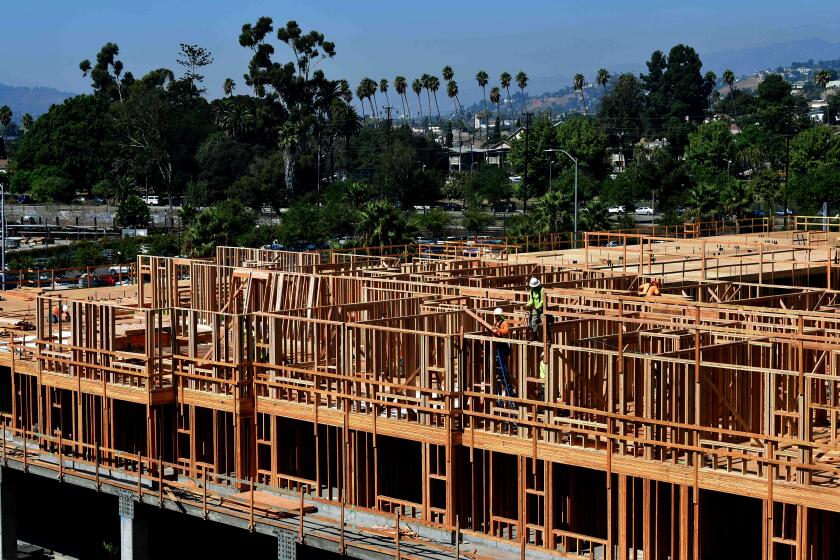‘Stuck’ in place: Author traces America’s mobility crisis to a Modesto law enacted in 1885

- Share via
Book Review
Stuck: How the Privileged and the Propertied Broke the Engine of American Opportunity
By Yoni Appelbaum
Random House: 320 pages, $32
If you buy books linked on our site, The Times may earn a commission from Bookshop.org, whose fees support independent bookstores.
Yoni Appelbaum kicks off “Stuck: How the Privileged and the Propertied Broke the Engine of American Opportunity,” his insightful book about our national housing crisis, with a personal story that will be all too familiar to any Angeleno trying to get ahead. Having settled nicely into a modest two-bedroom apartment in the formerly working-class neighborhood of Cambridgeport, Mass., with his wife and children, Appelbaum finds himself being financially squeezed by, well, just about everything. “Rent was costing us a third of our income each month, and it kept going up,” he writes. “An apartment with a third bedroom was beyond our reach.” Appelbaum’s friends and colleagues are moving away, some as far away as Africa, in order to afford their lives.
The cost of living is eating up salaries and savings across the country. Half of all renters spend 30% of their income on housing, the latest information from the U.S. Census Bureau shows, and a quarter spend 50% or more. Appelbaum suggests this his pinch points to a larger trend in American life: Instead of moving toward opportunity, we are moving away from it.
The author, a deputy executive editor of the Atlantic and former history lecturer at Harvard, skillfully blends zoning history with his own reportage, digging into the history of his apartment to find some answers. The building, a “three-decker” built a century ago, was constructed to suit the needs of New England’s industrial class. Now, it is inhabited by the 1%: “graduate students, doctors, architects, engineers.”
How did this come to pass? Appelbaum makes a compelling case for a “mobility crisis.” “Americans used to be able to choose where to live,” he writes, “but moving toward opportunity is now, largely, a privilege of the economic elite.” Where once we were a nation constantly on the move in search of a better life, forging new communities in the process, we now find ourselves priced out of urban centers and other traditional incubators of compensatory working life. Thanks in part to legislation that has choked off housing inventory, formerly working-class buildings like the one where Appelbaum resides are now out of reach for the working class.

The story of America is the story of migratory settlement, from the Puritans who broke from the Church of England and settled in Massachusetts in 1630 to the millions of European exiles in New York and other cities along the Eastern Seaboard by the early 20th century. According to Appelbaum, the traditional narrative of America has been turned upside down: A “nation of migrants” that once relocated in search of a better life is now staying put, victims of restrictive zoning laws and antigrowth regulation that has turned the country into a patchwork of exclusionary regions surrounded by low-income neighborhoods.
This post-disaster period should be an inflection point for government officials to take a hard look at how to speed up much-needed housing everywhere across the city and county.
Racial zoning covenants first gained traction in Modesto a few decades after the Gold Rush inspired a mad migratory dash to the region. When Chinese immigrants who had provided laundry services for prospectors began to creep in from the outskirts into predominantly white districts, locals tried physical intimidation and other tactics to force them out. When that didn’t work, Modesto’s city fathers in 1885 enacted an ordinance to force laundry services into an area that was already known as Chinatown.
Racial zoning policy spread across the Midwest and became a cudgel to sweep away those considered undesirable. Apartment dwellings, considered synonymous with urban blight, were banned in favor of single-family homes, while mostly white suburbs were kept off-limits to Black Americans and other minorities. The great migratory experiment that had created so much richness in American life had been shut down. “If mobility has been the key to producing American success,” Appelbaum writes, “then limited mobility has been the key to producing American inequality.”
Zoning became holy writ when FDR, as part of the New Deal, created the Federal Housing Administration, which offered home loans to a disproportionate degree among prospective white owners. By placing income caps on prospective homebuyers, “low-density sprawl and class-based segregation became a matter of public policy,” writes Appelbaum.
In one example he recounts, a war veteran eligible for benefits under the GI Bill was not able to get a loan in Flint, Mich., because local lenders weren’t willing to make them in Black neighborhoods.
Of the topics critical to California’s future, the cost of housing beats almost everything. Yet it has never emerged as a defining issue in the state’s politics.
Appelbuam argues that systemic racism and NIMBYism are not the only factors that have led to bad outcomes for minorities. Antigrowth social reform has also done its part to stifle housing inventory, increase rents and limit migration from town to city. In California, a state that “embodied the promise of American mobility” like no other, Ralph Nader began a campaign in the late 1960s to limit the conversion of “public goods into private assets” by discouraging real estate development and thus preserving the environment. Acting on that same impulse, then-Gov. Ronald Reagan in 1970 signed the California Environmental Quality Act, which meant that “almost every conceivable housing development” was now subject to government approval, piling on layers of environmental regulation and leaving developers open to lawsuits from “anyone with the time and resources to go to court.”
More than a century of restrictive real estate laws has turned the idea of mobility into “the privilege of an educated elite,” but Appelbuam has not given up hope that things can change. “Whatever policies we pursue, it’s important to strive for balance while preserving a sense of humility,” he writes. A middle way, between avoiding draconian preservation laws and “preserving vulnerable ecologies,” freeing our housing markets while guarding against abuses, is within our grasp.
But only if humanity and humility are part of the solution.
More to Read
Sign up for our Book Club newsletter
Get the latest news, events and more from the Los Angeles Times Book Club, and help us get L.A. reading and talking.
You may occasionally receive promotional content from the Los Angeles Times.












